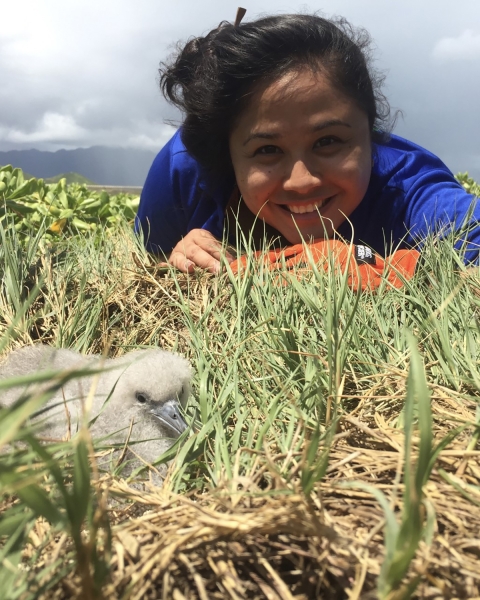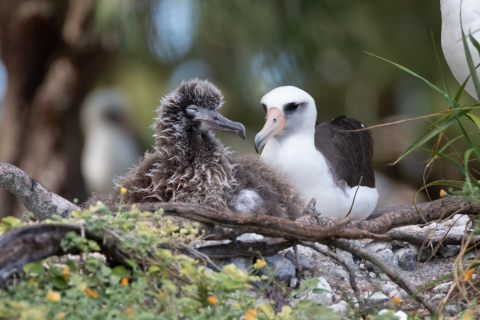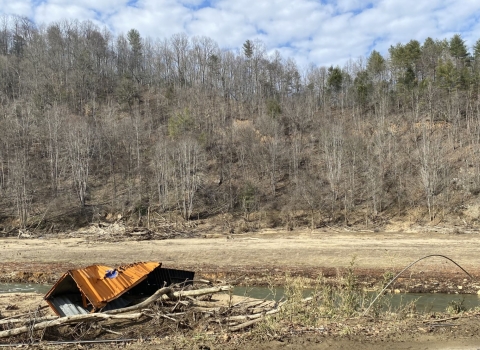Nanea Valeros grew up in Hawaiʻi where her passion for conservation started from a very young age. She just didn’t fully realize it was conservation at the time.
“Hula was always a very big part of my life. That’s where a lot my passion for conservation stems from. Hula is a form of storytelling, and I am blessed to have learned so many things from my kumu hula (hula teacher), not just relating to hula, but also relating to my broader responsibilities as a Native Hawaiian to be a true steward of this place.”
As a U.S. Fish and Wildlife Service employee, Valeros is determined to make sure other people – both Native Hawaiians and newcomers – don’t miss out on learning about conservation, wildlife and their ties to cultural traditions in Hawaiʻi.
“I’m from Hawaiʻi, born and raised,” Valeros said. “I didn’t know what a mōlī (Laysan albatross) was until I was in college. They’re culturally significant and they’re really cool birds! We have mōlī on Oʻahu, in two communities up on the North Shore and then on the west side. There are a lot of Native Hawaiians in those communities, and a lot of those kids probably don’t know much about these birds or that they exist in their own backyard.”
“I want to help people make the connection between these birds and their culture.”
That desire to connect people with the Hawaiian culture has inspired Valeros in her Service career. It is part of her job to teach and educate children – and adults – about the importance of native plants and animals in Hawaiian culture. In her public affairs specialist career in the Service’s Office of Communications, she specializes in outreach to Native Hawaiian communities.
“Part of my job is education and outreach and community engagement,” said Valeros, who has been with the Service for eight years. “One of the things that I’m working on is the albatross bolus education program. I’m trying to get more local schools involved in it.”
A bolus is the indigestible materials that are thrown up before an albatross chick goes out to sea (fledges) for the first time. They contain organic material such as squid beaks and fish eggs, and inorganic matter such as plastics.
These boluses are good indicators on the health of oceans and the current marine debris situation.
“Squid float near the surface of the ocean, and the albatross swoop down and scoop up the squid,” Valeros said. “But a lot of times they’ll also scoop up plastics, marine debris, netting, and plastic bags that also float on the surface. They’ll see things that may look like a squid or fish eggs and it’s actually trash. Then they return to the nest and feed that to their chick, and it’ll just sit in the chick’s stomach because they can’t digest it. When the chick is getting ready to fledge and they spit all that up, that’s all the non-digestible stuff we see in the bolus. We then collect the boluses and send them out to schools or take them to community events so that people can learn about albatross and how we use boluses to assess the health of our coastal and marine environments, and ultimately what community members can do to help improve the health of these places.”
Valeros’ passion for education also extends to in-reach to Service staff. She is a part of the Hui Hōʻai ‘Ike, a group that shares the traditional and historical knowledge of the indigenous and local communities whose traditional and customary practices in Hawaiʻ’i have contributed to and are integral to the stewardship of natural and cultural resources of Hawaiʻi.
“It originally started out as an Asian American Pacific Islander group before I was a part of the Service,” Valeros said. “Then in 2017, we officially became Hui Hōʻai ‘Ike, which means the group that feeds knowledge. We chose this name because it is our goal to educate, but also because in local style, whenever people gather, they eat and have a good time.”
One of the biggest challenges is educating staff – many of whom are not native to Hawaiʻi or the Pacific Islands – about incorporating Indigenous knowledge and cultural traditions into their work.
Part of that includes Species of the Month profiles of the native plants and animals. The profiles cover details about the species including biological information and distribution, but they also include cultural information.
“The majority of our staff are not born and raised here,” Valeros said. “The Hui Hōʻai ‘Ike puts together optional workshops and presentations to help staff bridge that gap so they can work better with the communities, including learning the native names of the places or the plants and animals. The more people are willing to learn, the better they’ll be able to work within these communities.”
That passion to educate people about Hawaiʻi’s culture drives Valeros in her career. Here are some additional excerpts from the discussion with Valeros.
Question: From a Native Hawaiian perspective, what is the biggest misconception by either tourists or people who have never visited the islands?
Answer: The biggest misconception is that this is paradise. It’s not. Everywhere you look, there’s invasive species invasive species
An invasive species is any plant or animal that has spread or been introduced into a new area where they are, or could, cause harm to the environment, economy, or human, animal, or plant health. Their unwelcome presence can destroy ecosystems and cost millions of dollars.
Learn more about invasive species . It’s still a beautiful place, yes; but it’s not reflective of the Hawaiʻi paradise our ancestors knew, and that is sad.
Q: As a Native Hawaiian, why is it important to be involved in the Service’s conservation work?
A: It’s important for me as a Native Hawaiian to be involved in the Service’s conservation work in Hawaiʻi because these species are integral to my culture and community. Native Hawaiians are the true stewards of the lands and waters of Hawaiʻi, and as such should be represented in all aspects of conservation work in Hawaiʻi. How would you feel if you invited someone over to your house and they took over and told you how to run your house?
Q: How can people be supportive of the Native Hawaiian community and the conservation efforts there?
A: Learn and use the native names of the species and places here. How would you feel if someone couldn’t pronounce your name correctly so instead decided to give you another name because it’s more convenient for them? Species and place names deserve the same respect.
Q: How does having children influence your perspective of conservation?
A: Everything I do is for my family. Even before I had kids, I was working toward the kind of Hawaiʻi I wanted to raise my family in. I want my kids to be proud of where they’re from and to be stewards of this very special place. I don’t care what career path they choose, but I want them to know they have a responsibility to take care of this place – their home.
Q: What are the crowning moments of your career with the Service?
A: Something I always enjoy is doing outreach at my kids’ schools. Seeing my kids in their element, explaining to their peers that they need to pick up their trash to help the albatross, is super cool to witness.
Another highlight for me was having Secretary Haaland attend one of our virtual Hui Hōʻai ʻIke ʻŌlelo Hawaiʻi workshops. She not only attended and participated, but she gave opening remarks in support of the work our hui does. She recognized the Native Hawaiians in the workshop and across Interior, and said that everyone can benefit from our experiences and perspectives, and that events like the ʻŌlelo Hawaiʻi workshop are an important part of cultivating working relationships with Interior, and honoring the federal government’s trust responsibilities to the Native Hawaiian community. The crowning moment for me wasn’t the recognition; it was the fact that the Secretary cared enough about the work to show up, share her own experiences as a native person, and really drive home the message that representation matters.





